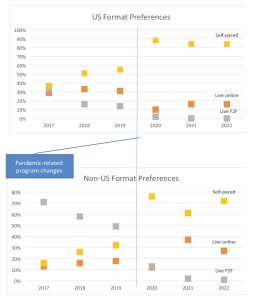
FEATURE STORY – By Tim Greiner
Post-pandemic, learners are still opting for virtual training
 If you’re like many training professionals, you’re wondering what the “new normal” will be for classroom training. This article explores the transition many of us made to wholly virtual learning during the pandemic, what we thought about our global learners then and what we’re still discovering about their needs and habits now.
If you’re like many training professionals, you’re wondering what the “new normal” will be for classroom training. This article explores the transition many of us made to wholly virtual learning during the pandemic, what we thought about our global learners then and what we’re still discovering about their needs and habits now.
We Had All the Time in the World
In 2019, many of us were already teaching at least partly online, but this was not as common in many parts of the world. We weren’t convinced that markets in South Asia and Latin America were ready for online training. Many believed that limited internet bandwidth or too strong a preference for in-person interaction would make online training unacceptable to learners in those regions.
This sentiment remained even as we watched 77% of U.S. learners choose to attend live events online when presented with both classroom and online options for the same course at the same price. So, we limited our online training rollout to parts of the world where we thought uptake would start first, such as China and Europe, while we continued working to convince our colleagues in other areas to give it a try.
We thought we had all the time in the world, but we didn’t.
When Tragedy Presents Opportunity
No doubt we all remember the day our organizations announced that we would be sending staff — at all sites — home home to work remotely for the foreseeable future due to the COVID-19 pandemic. That edict included immediately ceasing all international travel and in-person events.
For the U.S. education teams, this was handled with relative ease by quickly converting all classroom registrations to the online option. But what about the regional offices?
For some, the first inclination was to simply cancel all scheduled training events and wait out the pandemic. How long could it last, right? But as the severity of the situation became apparent, we recognized there was also an opportunity here. An opportunity to test our assumptions about our learners in various regions and to build some skillsets in online delivery.
This required a rapid change from the measured encouragement and episodic training in hybrid/online education of the regional delivery teams to a full digitization of global training activities. Staff had to learn and practice on the online delivery platforms, learner engagement technology, moderation techniques and a host of other new skills.
It didn’t all go swimmingly either. Because the ramp-up was so frenetic, many still ended up canceling live training events in the regions not already set up to teach online. But eventually, the entire program was back up and running in the virtual environment.
Now, would the learners still come?
Well, That Was Unexpected
The learners did come, but not the way we anticipated. We were so busy enabling live online delivery in regions where it had not yet become the norm, that we didn’t notice at first that the learners weren’t concerned about the live portion nearly as much as we expected.
Yes, much of the attendance that was face-to-face before did transition to live online during the pandemic. But far more learners opted for self-paced learning over live online formats. While this trend had already started before the pandemic, the degree to which it accelerated was dramatic.
What Does This Say About What’s Next?
As travel and in-person event restrictions ease, we wonder what new patterns of learner behavior will emerge. Will learners who have recently discovered the accessibility and convenience of online learning remain committed to that model? Will they long for the heady days of peer networking and direct interaction with the instructors, or even the break from the routine that expensed travel has to offer? We have some early indications that wherever they settle out, it’s not going to bean overnight transition like back in 2020.
In recent months, when we have introduced the in-person option back into the offering, learners have mostly opted to attend virtually. This is true both in the United States and in regions where we expected limited tolerance for online training.
What’s interesting is that in regions where we had not implemented online learning before the pandemic, learners are now selecting online over in-person at about the rate U.S. learners were before the pandemic. And in the United States, very few are opting to come in person. Sometimes, none are.
Anecdotally, we’re hearing some expressed desire for in-person options, but to date learners are not voting that way with their feet. And as learner population sage, more and more who are already attuned to online learning will be attending our classes, and they’ll want to do at least part of it virtually.
Tim Greiner is the senior director of USP education for the United States Pharmacopeial Convention. Email Tim at tag@usp.org.








